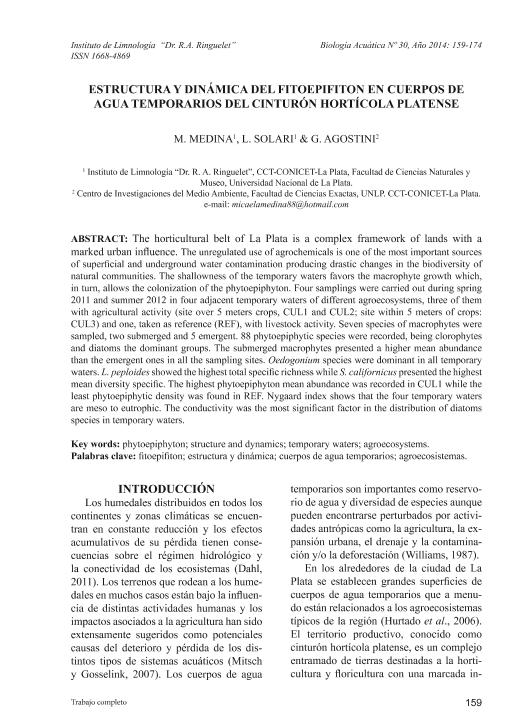Mostrar el registro sencillo del ítem
dc.contributor.author
Medina, Micaela

dc.contributor.author
Solari, Lía Cristina

dc.contributor.author
Agostini, Maria Gabriela

dc.date.available
2018-05-31T20:32:58Z
dc.date.issued
2014-11
dc.identifier.citation
Medina, Micaela; Solari, Lía Cristina; Agostini, Maria Gabriela; Estructura y dinámica del Fitoepifiton en cuerpos de agua temporarios del cinturón hortícola platense; Instituto de Limnología "Dr. R. A. Ringuelet"; Biología Acuática; 30; 11-2014; 159-174
dc.identifier.issn
1668-4869
dc.identifier.uri
http://hdl.handle.net/11336/46910
dc.description.abstract
The horticultural belt of La Plata is a complex framework of lands with amarked urban influence. The unregulated use of agrochemicals is one of the most important sources of superficial and underground water contamination producing drastic changes in the biodiversity of natural communities. The shallowness of the temporary waters favors the macrophyte growth which, in turn, allows the colonization of the phytoepiphyton. Four samplings were carried out during spring 2011 and summer 2012 in four adjacent temporary waters of different agroecosystems, three of them with agricultural activity (site over 5 meters crops, CUL1 and CUL2; site within 5 meters of crops: CUL3) and one, taken as reference (REF), with livestock activity. Seven species of macrophytes were sampled, two submerged and 5 emergent. 88 phytoepiphytic species were recorded, being clorophytes and diatoms the dominant groups. The submerged macrophytes presented a higher mean abundance than the emergent ones in all the sampling sites. Oedogonium species were dominant in all temporary waters. L. peploides showed the highest total specific richness while S. californicus presented the highest mean diversity specific. The highest phytoepiphyton mean abundance was recorded in CUL1 while the least phytoepiphytic density was found in REF. Nygaard index shows that the four temporary waters are meso to eutrophic. The conductivity was the most significant factor in the distribution of diatoms species in temporary waters.
dc.description.abstract
The horticultural belt of La Plata is a complex framework of lands with a marked urban influence. The unregulated use of agrochemicals is one of the most important sources of superficial and underground water contamination producing drastic changes in the biodiversity of natural communities. The shallowness of the temporary waters favors the macrophyte growth which, in turn, allows the colonization of the phytoepiphyton. Four samplings were carried out during spring 2011 and summer 2012 in four adjacent temporary waters of different agroecosystems, three of them with agricultural activity (site over 5 meters crops, CUL1 and CUL2; site within 5 meters of crops: CUL3) and one, taken as reference (REF), with livestock activity. Seven species of macrophytes were sampled, two submerged and 5 emergent. 88 phytoepiphytic species were recorded, being clorophytes and diatoms the dominant groups. The submerged macrophytes presented a higher mean abundance than the emergent ones in all the sampling sites. Oedogonium species were dominant in all temporary waters. L. peploides showed the highest total specific richness while S. californicus presented the highest mean diversity specific. The highest phytoepiphyton mean abundance was recorded in CUL1 while the least phytoepiphytic density was found in REF. Nygaard index shows that the four temporary waters are meso to eutrophic. The conductivity was the most significant factor in the distribution of diatoms species in temporary waters.
dc.format
application/pdf
dc.language.iso
spa
dc.publisher
Instituto de Limnología "Dr. R. A. Ringuelet"
dc.rights
info:eu-repo/semantics/openAccess
dc.rights.uri
https://creativecommons.org/licenses/by-nc-sa/2.5/ar/
dc.subject
Fitoepifiton
dc.subject
Estructura y Dinámica
dc.subject
Agroecosistemas
dc.subject
Cuerpos de Agua Temporarios
dc.subject.classification
Otras Ciencias Biológicas

dc.subject.classification
Ciencias Biológicas

dc.subject.classification
CIENCIAS NATURALES Y EXACTAS

dc.title
Estructura y dinámica del Fitoepifiton en cuerpos de agua temporarios del cinturón hortícola platense
dc.type
info:eu-repo/semantics/article
dc.type
info:ar-repo/semantics/artículo
dc.type
info:eu-repo/semantics/publishedVersion
dc.date.updated
2018-05-15T19:48:18Z
dc.journal.volume
30
dc.journal.pagination
159-174
dc.journal.pais
Argentina

dc.journal.ciudad
La Plata
dc.description.fil
Fil: Medina, Micaela. Consejo Nacional de Investigaciones Científicas y Técnicas. Centro Científico Tecnológico Conicet - La Plata. Instituto de Limnología "Dr. Raúl A. Ringuelet". Universidad Nacional de La Plata. Facultad de Ciencias Naturales y Museo. Instituto de Limnología; Argentina
dc.description.fil
Fil: Solari, Lía Cristina. Consejo Nacional de Investigaciones Científicas y Técnicas. Centro Científico Tecnológico Conicet - La Plata. Instituto de Limnología "Dr. Raúl A. Ringuelet". Universidad Nacional de La Plata. Facultad de Ciencias Naturales y Museo. Instituto de Limnología; Argentina
dc.description.fil
Fil: Agostini, Maria Gabriela. Consejo Nacional de Investigaciones Científicas y Técnicas. Centro Científico Tecnológico Conicet - La Plata. Instituto de Limnología "Dr. Raúl A. Ringuelet". Universidad Nacional de La Plata. Facultad de Ciencias Naturales y Museo. Instituto de Limnología; Argentina
dc.journal.title
Biología Acuática
dc.relation.alternativeid
info:eu-repo/semantics/altIdentifier/url/http://www.bacuatica.org/index.php/bacuatica/article/view/31
Archivos asociados
